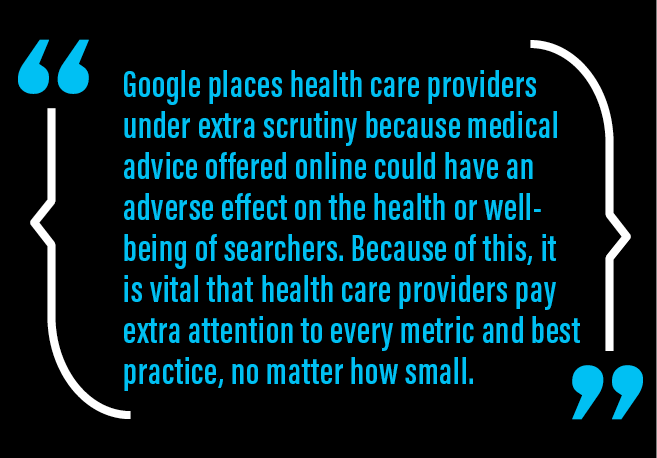When it comes to search engine optimization (SEO) and health care, only two statistics matter:
More than eight out of 10 patients use Google as their first step in researching a medical condition or selecting a physician1; and
Fewer than one in 100 patients will ever click through to page 2 (or beyond) of Google search results.2
A practice’s ability to appear high in organic search engine results pages is crucial for patient acquisition and growth. Bottom line: If your practice isn’t on page 1, you’re missing out on patients and revenue.
To help physicians and their marketing managers stay on top of the biggest developments in SEO, this article summarizes the major changes that occurred this quarter. Included are actionable tips and insights that practices can take to respond to market changes, stay on top of their online presence, and keep acquiring patients from organic search.
GOOGLE POSTPONES PAGE EXPERIENCE ALGORITHM UPDATE
What Happened
In April, Google announced that its Page Experience algorithm update (originally scheduled to roll out in May) was being delayed until June. As previously announced, Google reiterated that the update will be a gradual rollout, now expected to be completed in August, and that sites should not expect to see drastic swings in their rankings.
Google’s Page Experience algorithm is focused on Core Web Vitals metrics, which include:
- Largest Contentful Paint (LCP), or the speed at which a page’s main content is loaded. This should occur within 2.5 seconds of landing on a page.
- First Input Delay (FID), or the speed at which users are able to interact with a page after landing on it. This should occur within 100 milliseconds.
- Cumulative Layout Shift (CLS), or how often users experience unexpected layout shifts. Pages should maintain a CLS of less than 0.1.
Why It Matters for Health Care
This algorithm update has been a long time coming. With it, Google is placing more of an emphasis on websites that hit key Core Web Vitals metrics to provide a better user experience. Basically, the faster a website loads and becomes interactive to visitors, the better it tends to perform in Google’s search rankings. Google has hinted that websites that don’t hit all Core Web Vitals thresholds may not be demoted in rankings, but minimum thresholds for all Core Web Vitals are required in order to see a boost in rankings.
Google places health care providers under extra scrutiny because medical advice offered online could have an adverse effect on the health or well-being of searchers. Because of this, it is vital that health care providers pay extra attention to every metric and best practice, no matter how small. If you want to rank well on Google, your website needs to be in tip-top shape.
What Practices Should Do
Audit your page experience. How long does it take for your website to load and become interactive? Are any scripts or plugins slowing your page down? Don’t rely on your gut: Consult an SEO expert to have them run a Page Experience audit for you. It will be well worth the investment to identify problems and address them before Google begins taking Page Experience into account.

GOOGLE SEARCH LAUNCHES UPDATED MOBILE DESIGN
What Happened
In January, Google rolled out a redesign of its search results on mobile devices. The changes are intended to simplify the appearance of the results and make it easier for people to find what they are looking for. Primary changes include bringing key information into focus, making text easier to read, and using colors to highlight what’s important.
Why It Matters for Health Care
Organic search is the primary driver of new patient acquisition for most practices. Although it’s unlikely that this redesign will change your website’s rankings, there may be opportunities to exploit the changes for your benefit. The biggest change stemming from this redesign is likely to be in the click-through rate, or the percentage of users who click on a result after seeing it. Any change in click-through rates can have big effects on your website’s traffic and, in turn, on your patient pipeline.
What Practices Should Do
Google yourself on a mobile device and note what you see. Does your website’s logo appear as a favicon? Do featured images appear alongside search results, as they should? Contact your web developer or SEO agency to address any issues or inconsistencies you find. If any changes are necessary, they shouldn’t take long to implement—but they can make a world of difference to prospective patients.
GOOGLE ROLLS OUT PASSAGE INDEXING
What Happened
In February, Google rolled out its Passage Indexing algorithm update. This is an automated feature that pulls sections from pages into search engine results, even if the page covers a slightly different topic than the one searched. This update is intended to bring more relevant results that answer users’ questions from a variety of sources.
Why It Matters for Health Care
A lot of SEO experts were concerned about Passage Indexing rocking the boat, but its effect appears to be minimal. According to Google, Passage Indexing affects only 7% of all search queries. However, Passage Indexing can mean good things for practices that post long-form content. Passage Indexing pulls sections from long-form blog posts that cover a variety of topics and may display them in Google search results. If your practice routinely posts informational long-form content, you may receive a boost from this change.
What Practices Should Do
Look at Google Search Console and Google Analytics to see if any pieces of content have improved significantly in traffic. If so, you may have received a boost from Passage Indexing.
Think about your content strategy in collaboration with your marketing team and marketing partners. If you aren’t posting long-form content about the products or services your practice provides, now may be the perfect time to start.
MOVING FORWARD
Change is the only constant in the SEO world, and these changes can be difficult to navigate. As Google seeks to improve the experience and results it surfaces for its 1.7 billion daily active users, health care professionals must stay on top of these changes and adapt to continue serving their patients and growing their practices. Hopefully this quarterly SEO roundup will help.
1. Weaver J. More people search for health online. NBC News. Accessed June 9, 2021. www.nbcnews.com/id/3077086/t/more-people-search-health-online/%23.Xvn216dh1pQ#.Xv8nhhMpBpQ
2. Dean B. We analyzed 5 million Google search results: here’s what we learned about organic click through rate. Backlinko. Accessed June 9, 2021. https://backlinko.com/google-ctr-stats



